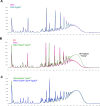This is a preprint.
Altered PBP4 and GdpP functions synergistically mediate MRSA-like high-level, broad-spectrum β-lactam resistance in Staphylococcus aureus
- PMID: 37961375
- PMCID: PMC10634853
- DOI: 10.1101/2023.10.26.564222
Altered PBP4 and GdpP functions synergistically mediate MRSA-like high-level, broad-spectrum β-lactam resistance in Staphylococcus aureus
Update in
-
Altered PBP4 and GdpP functions synergistically mediate MRSA-like high-level, broad-spectrum β-lactam resistance in Staphylococcus aureus.mBio. 2024 May 8;15(5):e0288923. doi: 10.1128/mbio.02889-23. Epub 2024 Mar 26. mBio. 2024. PMID: 38530033 Free PMC article.
Abstract
Infections caused by Staphylococcus aureus are a leading cause of mortality worldwide. S. aureus infections caused by Methicillin-Resistant Staphylococcus aureus (MRSA) are particularly difficult to treat due to their resistance to Next Generation β-lactams (NGB) such as Methicillin, Nafcillin, Oxacillin etc. Resistance to NGBs, which is alternatively known as broad-spectrum β-lactam resistance is classically mediated by PBP2a, a Penicillin-Binding Protein encoded by mecA (or mecC) in MRSA. Thus, presence of mec genes among S. aureus serves as the predictor of resistance to NGBs and facilitates determination of the proper therapeutic strategy for a staphylococcal infection. Although far less appreciated, mecA deficient S. aureus strains can also exhibit NGB resistance. These strains, which are collectively termed as Methicillin-Resistant Lacking mec (MRLM) are currently being identified in increasing numbers among natural resistant isolates of S. aureus. The mechanism/s through which MRLMs produce resistance to NGBs remains unknown. In this study, we demonstrate that mutations that alter PBP4 and GdpP functions, which are often present among MRLMs can synergistically mediate resistance to NGBs. Furthermore, our results unravel that this novel mechanism potentially enables MRLMs to produce resistance towards NGBs at levels comparable to that of MRSAs. Our study, provides a fresh new perspective about alternative mechanisms of NGBs resistance, challenging our current overall understanding of high-level, broad-spectrum β-lactam resistance in S. aureus. It thus suggests reconsideration of the current approach towards diagnosis and treatment of β-lactam resistant S. aureus infections.
Keywords: Methicillin-Resistant Lacking mec (MRLM); gdpP; pbp4; β-lactam resistance.
Figures








References
-
- Bui LMG, Conlon Brian P, Kidd Stephen P. 2017. Antibiotic tolerance and the alternative lifestyles of Staphylococcus aureus. Essays in Biochemistry 61:71–79. - PubMed
-
- Murray CJL, Ikuta KS, Sharara F, Swetschinski L, Robles Aguilar G, Gray A, Han C, Bisignano C, Rao P, Wool E, Johnson SC, Browne AJ, Chipeta MG, Fell F, Hackett S, Haines-Woodhouse G, Kashef Hamadani BH, Kumaran EAP, McManigal B, Achalapong S, Agarwal R, Akech S, Albertson S, Amuasi J, Andrews J, Aravkin A, Ashley E, Babin F-X, Bailey F, Baker S, Basnyat B, Bekker A, Bender R, Berkley JA, Bethou A, Bielicki J, Boonkasidecha S, Bukosia J, Carvalheiro C, Castañeda-Orjuela C, Chansamouth V, Chaurasia S, Chiurchiù S, Chowdhury F, Clotaire Donatien R, Cook AJ, Cooper B, Cressey TR, Criollo-Mora E, Cunningham M, et al. 2022. Global burden of bacterial antimicrobial resistance in 2019: a systematic analysis. The Lancet 399:629–655. - PMC - PubMed
Publication types
Grants and funding
LinkOut - more resources
Full Text Sources
